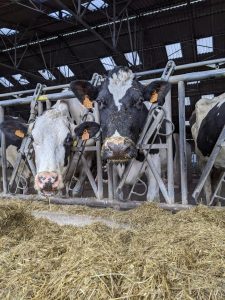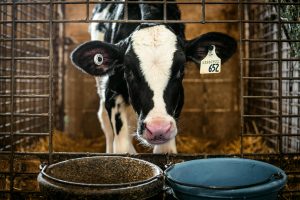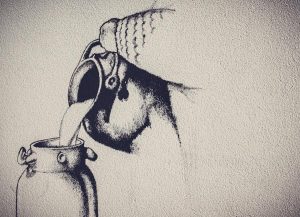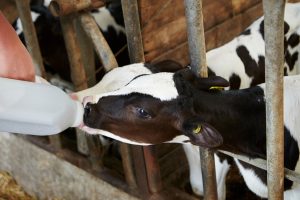Álvaro García
Milk urea nitrogen (MUN) is a low-cost, practical indicator that appears on most routine milk testing reports from processors and DHI services. While producers routinely track fat, protein, somatic cell count, and yield, MUN offers unique insight into how well dietary protein is being utilized by the cow. Among all the macronutrients in a dairy ration, protein is typically the most expensive per unit when supplemented, making it especially important to monitor its use efficiency. When MUN is too high, it may indicate that protein is overfed or is not well balanced with fermentable energy. If too low, it can suggest protein shortages that may limit performance.
What makes MUN especially valuable is that it does not require extra testing or cost, you are likely already receiving this data. Interpreting MUN alongside dietary factors, especially the ratio of non-fiber carbohydrates (NFC) to crude protein (CP), can help adjust rations to reduce feed waste and improve nitrogen efficiency. Lowering MUN also reduces urinary nitrogen losses and the formation of ammonia in barns, which not only benefits the environment but also improves air quality and preserves the nutrient value of manure. At a time when feed costs are high and environmental expectations are growing, MUN is a simple, accessible tool to help producers make more informed and cost-effective feeding decisions.
Main dietary contributors to MUN
Recent research, including a comprehensive meta-analysis by Zhao et al. (2025), has helped clarify which dietary components most strongly influence MUN concentrations. One of the most consistent findings was the importance of the dietary NFC to CP ratio. When this ratio was too low (i.e., high CP relative to NFC), MUN tended to rise. When the ratio was too high, indicating insufficient protein, MUN dropped. This relationship highlights the importance of balancing rumen-available energy and protein to ensure efficient microbial protein synthesis and minimal nitrogen waste.
Follow these general guidelines for the best balance:
- Keeping MUN average between 8 and 16 mg/dL helps balance feed efficiency and nitrogen losses.
- Maintaining NFC/CP ratios between 2.15 and 3.60 are generally associated with MUN in the desired range.
- Consequences of extreme MUN values:
- MUN >16 mg/dL may indicate excessive protein or insufficient fermentable energy. Solutions include lowering dietary protein or adding energy (e.g., ground corn, molasses).
- MUN <8 mg/dL can suggest protein deficiency, requiring evaluation of CP sources or increasing rumen-degradable protein.
Because urea from urine is rapidly converted into ammonia, high MUN also contributes to ammonia emissions, affecting barn air quality and nitrogen losses from manure. By optimizing MUN, producers not only reduce input costs but also lower emissions and retain more nitrogen in the manure for use as fertilizer.
Pasture-based vs. TMR-fed cows
While the NFC/CP ratio is a key factor influencing MUN, it is important to recognize that MUN responses can differ depending on the production system. In confinement operations, where cows are fed a total mixed ration, producers have more control and can adjust the balance of CP and NFC with precision. In contrast, grazing systems allow cows to selectively consume the most vegetative parts of the plant, oftentimes the top one-third to one-half of the sward, which are typically higher in crude protein and lower in readily fermentable carbohydrates. This selection behavior, especially during periods of rapid pasture growth, results in increased dietary rumen-degradable protein relative to energy, often leading to elevated MUN. It is not uncommon for grazing herds, particularly those on vegetative, lush pasture, to show MUN exceeding 20 mg/dL without necessarily indicating poor management.
Legumes like clovers and alfalfa tend to have much higher crude protein concentrations than cool-season grasses such as ryegrass, fescue, or orchardgrass. While this can support high milk production, the protein-to-energy imbalance in these diets can elevate MUN. To address this, farmers in grazing systems may need to supplement energy-dense feeds such as corn grain, molasses to improve the NFC/CP ratio, rather than reduce pasture intake. Unlike TMR-fed herds, where reducing protein ration ingredients is often the first strategy to lower high MUN, grazing herds typically require energy supplementation to match the naturally high forage protein. Table 1 shows suggested energy supplementation (in kg of DM per cow/day) to help balance the high protein content and manage MUN levels effectively under grazing conditions.
These are estimates based on typical corn NFC (~85–90% DM) and intended for illustrative purposes. Exact inclusion rates should be adjusted by your consulting nutritionist.
Table 1. Pasture type, MUN, and Energy supplementation |
|||
|
Pasture type |
Crude protein (% DM) |
Estimated MUN (mg/dL) |
Recommended Additional Grain (kg DM/day) |
|
Vegetative Ryegrass |
22 |
18 |
2.0 |
|
Red Clover (vegetative) |
24 |
21 |
2.8 |
|
Alfalfa (vegetative) |
23 |
20 |
2.5 |
Because of these dynamics, interpreting MUN in grazing systems requires context. What might be considered high in a confinement herd may be physiologically normal in well-managed grazing herds during certain periods. Still, persistently high MUN levels in grazing herds should prompt evaluation of pasture composition and supplementation strategy to ensure efficient nitrogen.
How to use MUN on the farm
- Review MUN regularly in milk reports, many processors and DHI services include it at no extra cost.
- Watch the trend, not just single values. If herd MUN drifts consistently high or low, it may indicate a diet imbalance.
- Work with your nutritionist to monitor NFC and CP levels and calculate the NFC/CP ratio.
- Aim for efficiency by keeping more nitrogen in the cow and out of the lagoon or the air.
Table 2 helps adjust the balance between NFC and crude protein CP in dairy rations. It provides estimated amounts of ground corn needed to reach specific NFC/CP ratios. These values offer a general guide based on common nutritional assumptions and should be refined based on actual ration composition and herd performance (Garcia, A. 2025).
Table 2. Estimated ground corn additions to improve NFC/CP ratio |
|||
|
Current CP (%) |
Target NFC/CP ratio |
Target NFC (%) |
Corn addition (kg/cow/day) DM basis |
|
16 |
2.5 |
40 |
~2.3 |
|
16 |
3.0 |
48 |
~4.2 |
|
17 |
2.5 |
42.5 |
~2.9 |
|
18 |
2.5 |
45 |
~3.5 |
|
18 |
3.0 |
54 |
~5.5 |
While adding ground corn or other rapidly fermentable carbohydrates can help lower high MUN, it’s critical not to sacrifice fiber effectiveness or rumen health in the process. Excessive NFC and inadequate fiber can predispose cows to subacute rumen acidosis (SARA), decreased butterfat, and poor cud chewing. Always evaluate changes in the context of the total diet, including effective fiber, total starch load, and particle size, and consult with your nutritionist before making significant adjustments.
Milk urea nitrogen is a valuable yet often underused tool for improving the efficiency of protein use in dairy herds. It provides insight into whether the most expensive nutrient in the ration (protein) is converted into milk or wasted through nitrogen excretion. Because MUN reflects the interaction between dietary protein and fermentable carbohydrates, it serves as a practical indicator of how well the ration is balanced for microbial protein synthesis in the rumen.
Recent research reinforces that the NFC/CP ratio is one of the most reliable predictors of MUN concentration and nitrogen efficiency. When MUN is kept within the target range of 8 to 16 mg/dL, it typically reflects more efficient use of nitrogen, lower urinary losses, and better use of feed resources. Adjustments to this ratio—by either increasing NFC or reducing excess protein—can lead to meaningful improvements in feed cost control. Practical feeding adjustments, such as including ground corn to raise NFC, can help correct imbalances when applied carefully and in the context of the entire diet. Beyond nutritional efficiency, maintaining optimal MUN also has environmental benefits. High urinary urea results in more ammonia emissions, reducing barn air quality and diminishing the fertilizing value of manure. Lowering MUN can help minimize this nitrogen loss and align the farm with sustainability goals increasingly expected by the public, regulators, and milk buyers. By reviewing MUN reports regularly, watching trends, and collaborating with a nutritionist to interpret results in the context of diet formulation, producers can take full advantage of this parameter. Doing so allows for more precise protein feeding, cost savings, improved health, and reduced environmental impact.
© 2025 Dellait Knowledge Center. All Rights Reserved.









